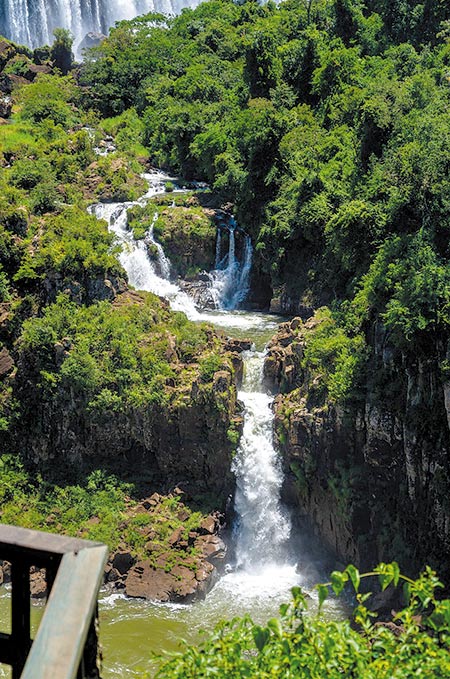

Charming city
Puerto Iguazu is a charming city marked by a vibrant local culture, surrounded by lush subtropical forests and scenery, and artisan markets. Visitors can explore the markets or experience the local cuisine and hospitality. Its location near the tri-border area gives it a unique vibe.
"The national park is a 30-minute drive from downtown Puerto Iguazu," said Micaela Pereyra, a travel agent. Tours can be easily booked from there as well.
Pereyra recommends staying at least two nights to explore the Argentine side of the Iguazu National Park and the Brazilian side "which, though featuring fewer waterfalls, offers a unique perspective of the falls".
"Visiting the Brazilian side typically requires three or four hours, including crossing the land border between Argentina and Brazil," said Pereyra.
"If you have a free afternoon, consider visiting the Three Borders Landmark, where Argentina, Brazil and Paraguay meet. The site features a daily light and sound show," Pereyra said.
"Longer stays in Puerto Iguazu offer opportunities for horseback riding in the jungle or visiting Guira Oga, an animal rescue center where guided tours showcase the work done with rescued wildlife," Pereyra added.
The falls have become increasingly famous over the last few decades. They are often featured in Hollywood movies and are, since 1984, a UNESCO World Heritage Site.
They are also at the heart of one of South America's most crucial subtropical rainforest ecosystems, with more than 2,000 plant species and wildlife such as tapirs, giant anteaters, howler monkeys, ocelots, jaguars and caimans. There are also hundreds of birds, butterflies, and curious coati mammals in store for visitors on the Brazilian side of the falls.
The best time to visit the falls is from October to March. Visitors who choose to travel as part of groups usually spend two days traveling to Iguazu Falls from Buenos Aires, said Esteras, the Vivaterra CEO.
On the first day, groups often explore the Argentine side of the falls, which has three different circuits. Visitors can take inflatable boat rides to get closer to the falls.
"The lower circuit allows for close-up views of the river and falls from below. The upper circuit offers views of the river before it cascades into the falls, offering an incredible perspective," Esteras said. "The highlight is the Devil's Throat, one of the most impressive."
On the second day, visitors often explore the Brazilian side, which offers a more panoramic — albeit more distant — view of the Iguazu.
"While 80 percent of the falls are on the Argentine side, the most picturesque photo opportunities, with all the falls visible at once, are from the Brazilian side," said Esteras.
Argentina, Brazil and China have taken steps to strengthen tourism relations. Brazil, for instance, recently introduced a 10-year visa policy to encourage travel and business exchanges.
Argentina has become a key destination for Chinese tourists, many of whom are attracted by the country's reputation as a soccer powerhouse or won over by the increased connectivity between the two countries, as well as visa assistance for Chinese tourists.
This trend is visible throughout Latin America, with Brazil, Argentina and Peru the most popular destinations in the region during the first few months of 2024, according to the Chinese travel portal Qunar. The portal recently noted that Chinese tourists are increasingly likely to choose exploratory or immersive natural experiences during visits to Latin America.
Helicopter rides over Iguazu Falls and hikes in the rainforest are among the top choices, but horse rides and boat rides are also common, as are food tours and shopping excursions.
Tourism authorities throughout the region have taken steps to make visits easier and more accessible. In 2017, Brazil and Argentina launched a joint tourism promotion program, including promotional tours in Beijing, Shanghai and Guangzhou, to woo more visitors from China. The Brazilian Tourist Board announced plans to join China's travel trade show in Shanghai this year.
"We have found Chinese visitors to be easy to work with, always pleasant and eager to explore remote places," said Esteras.